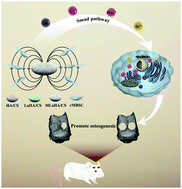Generally, the addition of exogenous stem cells and host-to-scaffold immune responses restricts the clinical applications of hydroxyapatite (HA)/chitosan (CS) scaffolds for bone regeneration. To achieve “facilitated endogenous tissue engineering”, magnetic M-type hexagonal ferrite (SrFe12O19) nanoparticles were incorporated into bone scaffolds to recruit endogenous stem cells. Then, lanthanum incorporation was utilized to regulate host-to-scaffold immune responses and to provide a pro-regenerative environment for recruited endogenous stem cells. Here, we first fabricated and characterized magnetic lanthanum-doped HA/CS scaffolds. The MLaHA/CS scaffolds were demonstrated to be effective at recruiting rat bone marrow mesenchymal stem cells (rBMSCs) and modulating host-to-scaffold immune responses by promoting macrophage polarization into the anti-inflammatory phenotype (M2) in vitro. By further examining the underlying mechanism, we found that MLaHA/CS scaffolds could promote the osteogenic differentiation of rBMSCs by upregulating the phosphorylation of the Smad 1/5/9 pathway. When MLaHA/CS scaffolds were implanted into rat calvarial defects, the incorporation of magnetic nanoparticles and lanthanum significantly promoted the new bone regeneration, as revealed by micro-CT assays and histological staining. Our findings suggest that MLaHA/CS shows great potential for use as a cell-free and biocompatible scaffold for bone regeneration.
